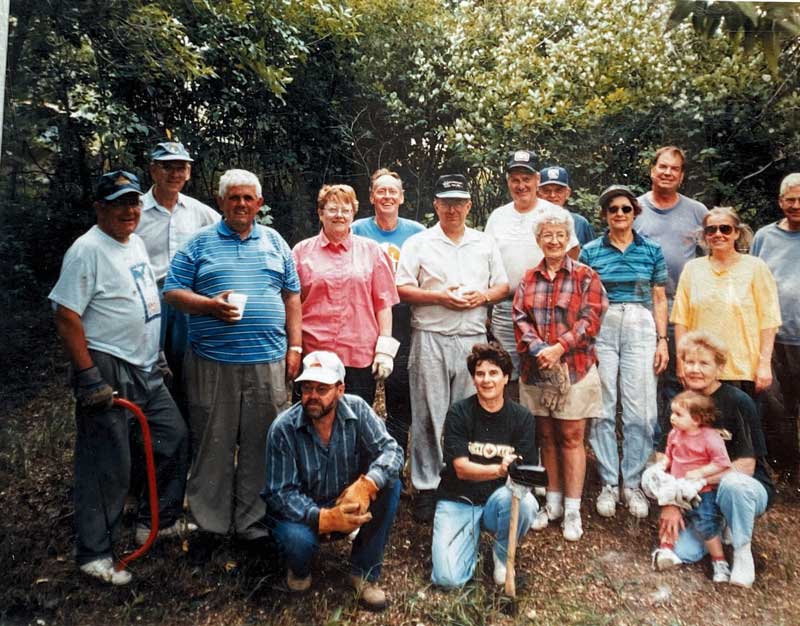History, Culture, and Heritage of the Katepwa District
The following are excerpts from the book “Lake Katepwa: Memories of Yesterday with Notes for Today”
Copyright 1984, Author: John Archer, Publisher: Lake Katepwa Historical Society
Pimple Hill:
“Pimple Hill”, as it is affectionately named, is a recognizable landmark in the District of Katepwa. It is the hill that is located across Highway 56 from the Katepwa Provincial Park. Face inland while at the Katepwa Point Provincial Park, and look up – you will see a Pavillion on its peak. It can be reached by walking along the nature trail that leads to the top of the hill. Enjoy the view!!
The little house on the hill with the flag on the top of it. Where we all climbed to carve our names and look over the valley below. Whist, cribbage, bridge, horseshoe, pulling toffee, home-made bob-sleds for riding down the hills and church on Sunday at Sacred Heart Catholic Church. Hunting in the fall was enjoyed by all. Joe always had his big Black Labrador dogs, well trained for retrieving the game — ducks, pheasant, prairie chicken and grouse. (pg 35)
Brick Factory:
The first brick factory was built by Arthur James Osment near Fox Coulee, east of Indian Head, about 1882. He was a Londoner who had migrated to Canada in the early 70s and came west of build the Bell Farm, north of Indian Head. Clem Peltier ran the factory for him. Mr. Osment built many houses and public buildings in Indian Head and the surrounding country.
About 1898, Mr. Osment moved the brick factory to Lebret, but it was not a success. He sold the equipment to Mr. Clem Peltier, who moved to the end of Lake Katepwa and opened up a brick factory opposite the old school house.
In 1904, Mr. Osment, an excellent contractor, built the Opera House Block in Indian Head. He secured his bricks from Clem Peltier’s brick factory at Katepwa. It was a tremendous undertaking transporting tons of bricks up the old Highway 56, when the road was sometimes wet and a real quagmire.
He obtained his material from near at hand; the sand pits a few miles away, the lime from a hill on the way to Lebret near the old Vidal homestead, some the of cement was imported, and the water, of course, from the lake.
For several years, he supplied bricks to farmers and for buildings like the hotels at Cupar and Yellow Grass. A.J. Osment’s daughter, Mrs. Ann Widdup, tells the story that people viewing the huge fire built under the bricks to cook them could be seen for miles and reminded them of what it might be like to be in Hell! Due to competition, Clem was forced to quit the business in 1907 or 1908 and after a few years the bricks gradually disappeared. (60)
Syndicate properties:
The Katepwa Beach Syndicate was formed about 1914. It was made up of landowners of the quarter section of land where the townsite currently exists. The syndicate put caveats on the property in order to regulate the sale of property and sanitation in the townsite. The street names that were in existence in 1911 are still in use today.
Soon after the Syndicate was formed, the resort grew to include the hotel, a dance hall and an 18 hole golf course.
(The following excerpts from a letter written by one of the originals of the group explain the purposes of the Syndicate formed. The letter is dated October 4, 1944 and is quoted by permission)
“When I came to Regina in 1910, I looked around the various lakes to locate a summer resort and after a full investigation I decided that what was then known as Vidal’s Point on Lake Katepwa was the most attractive within reasonable reach of Regina. At that time Mr. Eli Williamson of Indian Head, who owned the quarter section, part of which was in the lake, had had a survey made of some of the shore lots and these were known on the plan as the townsite of Vidal’s Point. These shore lots extended from the road allowance to the south some distance along the shore in a northwesterly direction beyond the property which I eventually purchased. At that time there were no cottages or other building erected and the Government beach had no provision for sanitation so that were so assurance of the place being properly supervised or cared for even on the Government property.
Before I would go the expense of building a cottage I decided that I must in some way get control of the whole quarter section and I got some other Regina citizens to go in with me to form a syndicate which is and has been known as the Katepwa Beach Syndicate. The Syndicate purchased the whole quarter section from Mr. Williamson and then further subdivided it and this further subdivision was known as the Townsite of Katepwa beach. I had the first choice of lots, which I bought from Mr. Williamson, namely 13 and 14 on Vidal’s Point, which game me 100 feet of frontage. I decided however after further consideration that 100 feet of frontage did not give me sufficient isolation and consequently I bought the adjacent lots on either side of 13 and 14, namely, lots 12 and 15, giving me 200 feet of frontage.
In the original story of Vidal’s Point, as you may realize, the lots front on the lake and extend over 200 feet back from the lake with a lane at the back of some. The survey of Katepwa Beach provides for this lane continuing back of the shore lots and for a further tier of lots extending from this lane some 200 feet further back and fronting on a street which is set out in the survey. This street has not yet been opened up because it has not been necessary to do so. Everybody had accepted the driveway that is at present in existence and I imagine no one will want to interfere with the present driveway as it is convenient to all parties who have lots in that area.
Now as to the caveat. Immediately we surveyed Katepwa Beach, the Syndicate placed a caveat against all the property and any property that has been sold of the Katepwa Beach survey is sold subject to the caveat. The object of the caveat is not only a protection to ourselves as a syndicate, but a protection to everyone who buys any property from the Syndicate or who has bought any property from the Syndicate. This caveat is to ensure that those who buy will be acceptable to the and also to ensure that any buildings that are erected will be approved of by the Syndicate and that no business in the form of a nuisance or otherwise shall be carried on on any or these lots. It also gives us full control in a sanitary way so that we can insist on proper sanitation being installed by anyone who is occupying any of the lots in question. In other words the caveat is the usual class of caveat that is put on a summer resort subdivision in order to ensure that reasonable control over the whole set up and is undoubtedly to the advantage of everyone who acquires and interest in the subdivision.
I am sure that with this explanation you would not want that caveat removed and I am also sure that the Syndicate would not agree to have it removed. The Syndicate will not remove the caveat from any lot in the survey because the value of the whole subdivision as a summer resort largely depends on having proper control as to ownership and us of lots within the survey.” (62,4)
Dance Hall:
There was a dance hall that was located on Regina Avenue. It no longer exists, as it was torn down after the publishing of the History book in 1984.
The dance hall, which still stands, was built some time later and will be remembered by many old-timers as the centre of community entertainment. In its early years most often the bands were formed from local residents, and its twice-weekly dances were heavily attended by most of the cottagers. Later, of course, the dance hall drew from a wider audience and, particularly during the big-band era, was a very popular spot on Saturday nights from as far away as Regina. (pg 64)
Marion Robinson fishing
Thursday at Salter’s Beach, near Katepwa, Mrs. Wm. Robinson of 2039 Robinson Street, hooked a pike which weighed in at 19.5 pounds.
Although she’s no green hand at landing big ones, Mrs. Robinson said afterwards, “It was quite a struggle and at the finish we were both all in!” (179)
All Saints’ Anglican Church
This Church was designated a Municipal Heritage Property in 1990.
The All Saints’ Anglican Church Katepwe was built in 1886 on the southeastern shore of the lake, in a small settlement then known as Lauder’s Town. John Lauder, the owner of the townsite, donated that land.
Construction started in July of 1886 with the hauling of stones from nearby fields, to be used for the foundation. The main structure is wood and concrete. The church was not fully completed until after its consecration on August 21, 1887.
Although the church was not completed until 1887, the members of its congregation held Anglican services in local homes and the schoolhouse as early as 1884, and this is considered the year of origin for All Saints’ Anglican Church Katepwe.
The graveyard beside the church is the final resting place of many original settlers.
Regular services ceased in 1945 and the church was only used in July and August. By the 60s the building was in poor condition, leaning from the pressure of the chimney. The exterior was repaired, followed by a complete refurbishment of the interior by the end of the 70s. Electricity was installed in 1982. Congregation members throughout the years have made maintenance of the church and churchyard possible by various donations and bequests.
History of the Trail
We would like to acknowledge the extensive ground work done by many to get our Katepwa Lake Trans Canada Trail started, be it negotiating with the Department of Highways or individual landowners, meeting with the village of Katepwa, and/or many hours of volunteer labour.
The idea of a trail was begun in 1987 but it was in August 1998 that the first meeting of the Katepwa Lake Trans Canada Trail was held. The Trans Canada Trail was the brainchild of the Canada 125th birthday celebration. The Trail has been maintained and improved by volunteers since inception and is now a busy and valued asset to the District of Katepwa.


